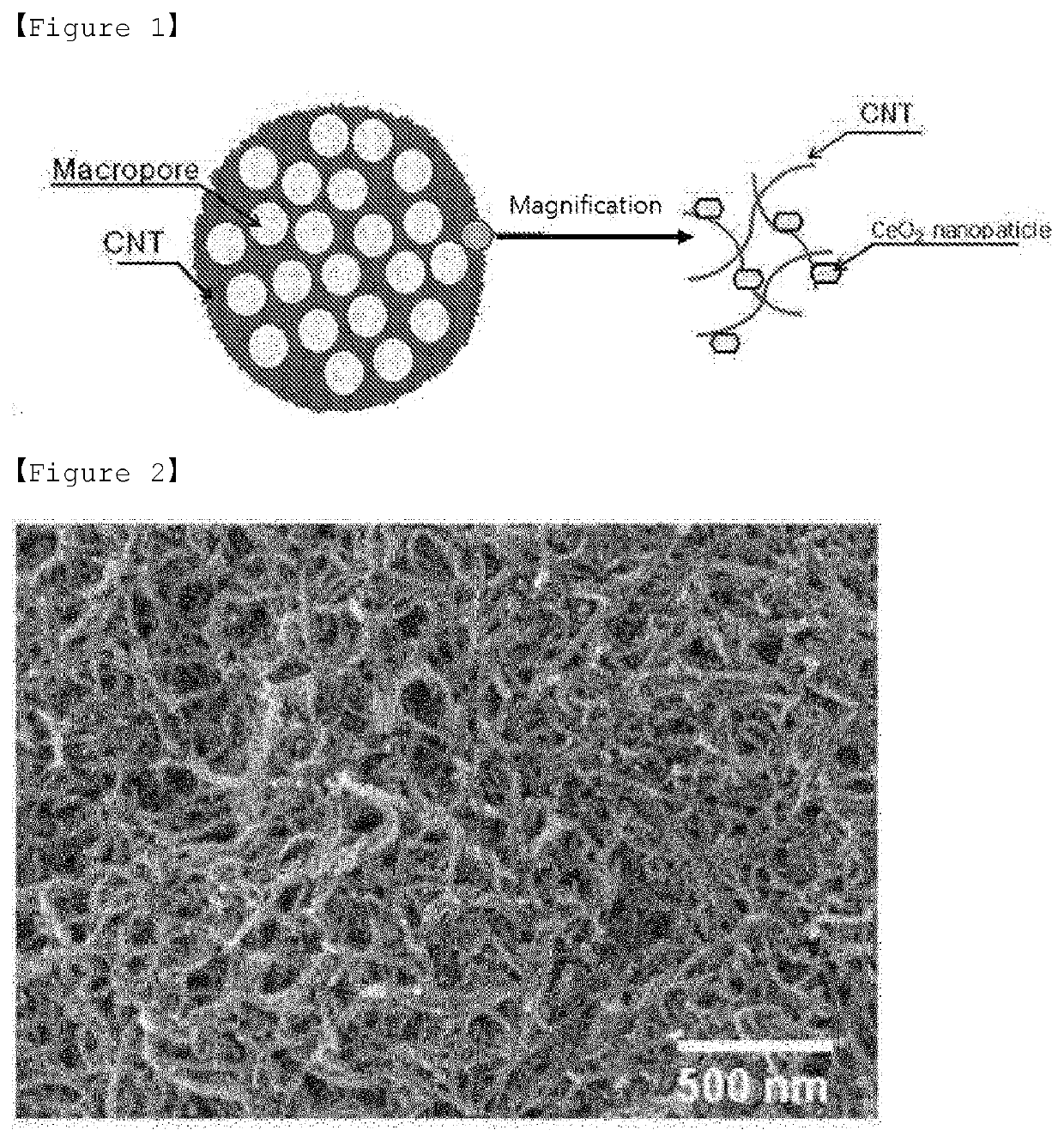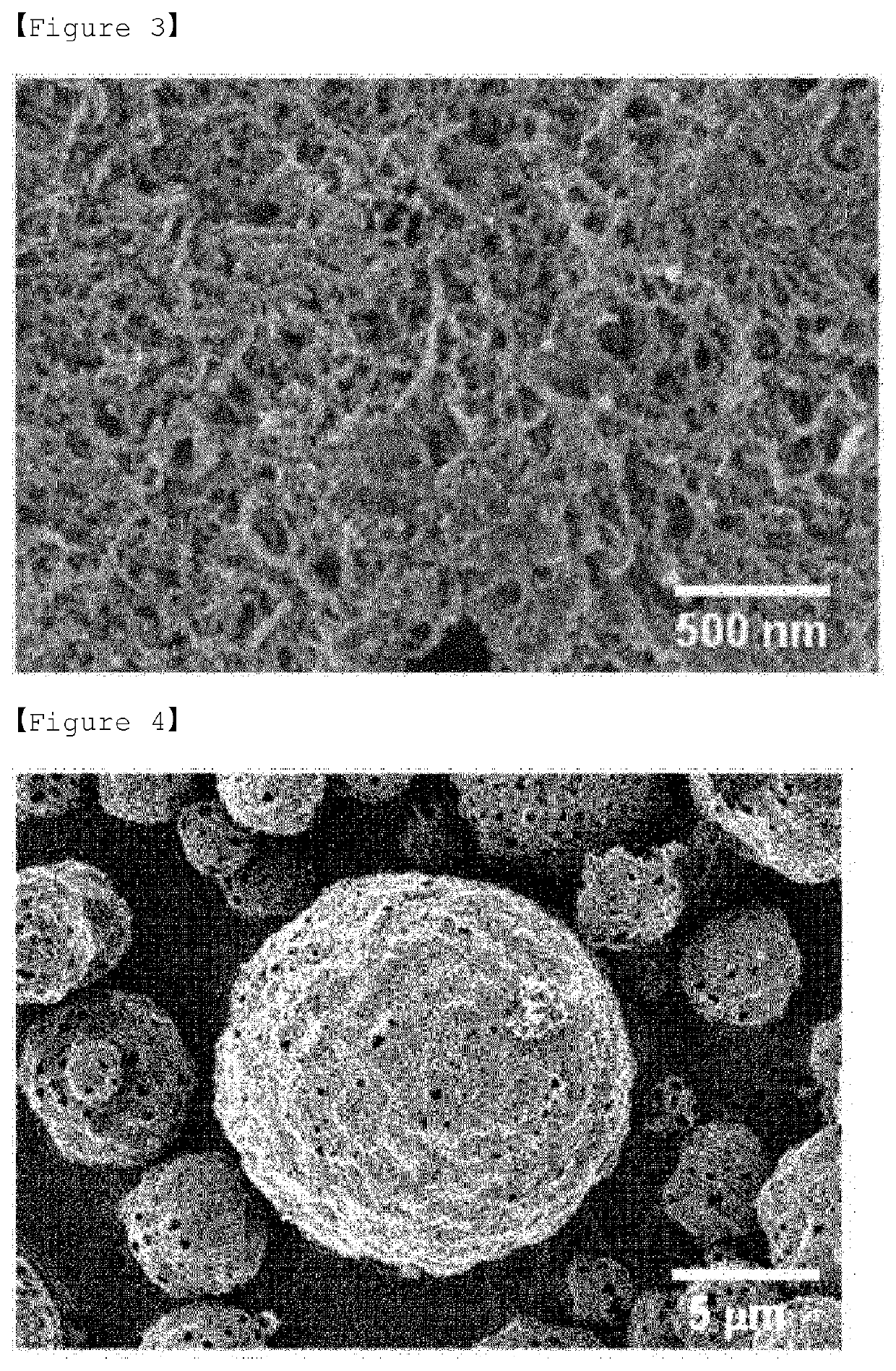Ceria-carbon-sulfur composite, method for preparing same, and positive electrode and lithium-sulfur battery comprising same
a technology of carbon-sulfur composite and positive electrode, which is applied in the direction of sulfur preparation/purification, cell components, electrochemical generators, etc., can solve the problems of low coulomb efficiency and rapid capacity reduction according to charging/discharging, and the electrochemical properties are not fully expressed, so as to improve the lifetime and electrochemical characteristics of the electrode, improve the stability of the electrode, and improve the effect of electron conductivity
- Summary
- Abstract
- Description
- Claims
- Application Information
AI Technical Summary
Benefits of technology
Problems solved by technology
Method used
Image
Examples
example 1
[0158]An aqueous dispersion was prepared by mixing aqueous dispersion of multi-wall carbon nanotube (MWCNT, diameter: 10˜20 nm) and polystyrene (PS, diameter: 500˜600 nm) colloid solution with MWCNT: PS=1 g:3.5 g ratio.
[0159]Polystyrene-carbon nanotube (PS-MWCNT) composites were prepared by spray-drying (Labplant, SD-Basic) the dispersion at 140° C. The PS-MWCNT composite was recovered and then polystyrene was removed by heat treatment at 500° C. for 2 hours in argon (Ar) atmosphere to produce a carbon nanotube agglomerate having a hierarchical porosity structure (FIG. 2).
[0160]0.45 g of the obtained carbon nanotube agglomerate and 0.9 g of Ce(NO3)3.6H2O were added to distilled water and heated to a temperature of 95° C. While keeping the above temperature, 1.75 g of 6-aminohexanoic acid and 0.07 mL of hydrochloric acid were added and hydrothermal synthesis was conducted for 5 hours.
[0161]After completion of the synthesis, the mixed solution was washed several times with distilled w...
example 2
[0168]A mixture of the ceria-carbon-sulfur composite prepared in Example 1, a conductive material and a binder in a weight ratio of 8:1:1 was dissolved in distilled water to prepare a positive electrode active material slurry, and then coated on a current collector of aluminum foil having a thickness of 20 μm to prepare a positive electrode.
[0169]Carboxy methyl cellulose (CMC) was used as the conductive material, and styrene butylene rubber (SBR) was used as a binder.
[0170]A lithium-sulfur battery coin cell was fabricated using polyethylene as a separator and lithium foil with a thickness of 45 μm as a negative electrode. At this time, a coin cell was prepared using an electrolyte solution prepared by dissolving 1 M LiFSI and 0.5 M LiNO3 in a mixed solvent of diethylene glycol dimethyl ether and 1,3-dioxolane in a volume ratio of 1:1.
PUM
| Property | Measurement | Unit |
|---|---|---|
| BET specific surface area | aaaaa | aaaaa |
| porosity | aaaaa | aaaaa |
| diameter | aaaaa | aaaaa |
Abstract
Description
Claims
Application Information
 Login to View More
Login to View More - R&D
- Intellectual Property
- Life Sciences
- Materials
- Tech Scout
- Unparalleled Data Quality
- Higher Quality Content
- 60% Fewer Hallucinations
Browse by: Latest US Patents, China's latest patents, Technical Efficacy Thesaurus, Application Domain, Technology Topic, Popular Technical Reports.
© 2025 PatSnap. All rights reserved.Legal|Privacy policy|Modern Slavery Act Transparency Statement|Sitemap|About US| Contact US: help@patsnap.com



